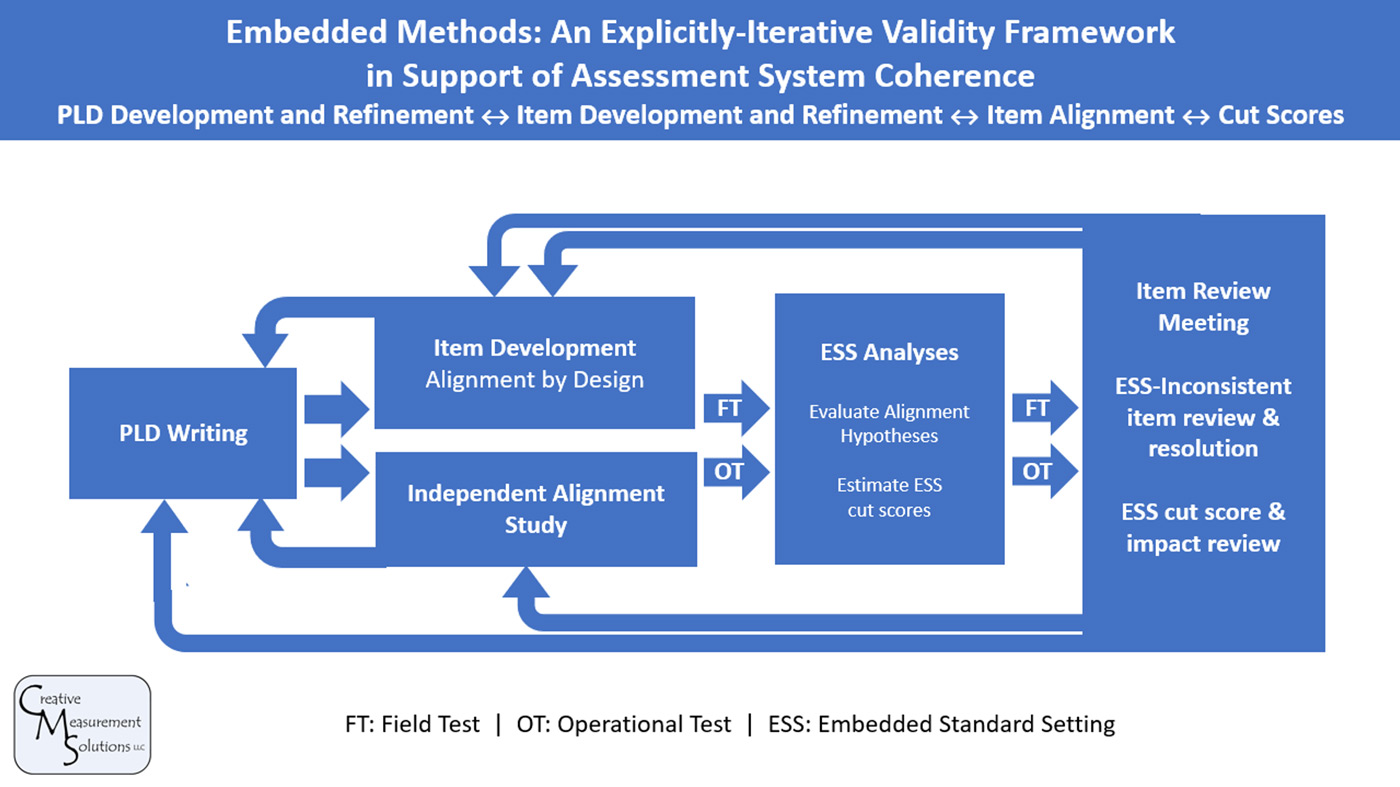SIPS Measurement Models and Psychometric Methods
The SIPS measurement team is investigating multiple SIPS measurement models to provide feedback to educators, parents, and students about the status of student science learning. The first approach employs contemporary psychometric methods for modeling student learning based on evidence from multidimensional assessment tasks (Ackerman, Gierl, & Walker, 2003; Briggs & Wilson, 2003). Multidimensional item response theory modeling (mIRT), particularly the multidimensional Rasch model, will provide initial calibrations of task difficulty across students at each of the targeted grades. The second approach, situated in a principled assessment design (PAD) framework, employs Embedded Standard Setting (ESS; Lewis & Cook, 2020) and, more broadly, Embedded Methods (Lewis & Forte; 2021) that support an iterative approach to test development.
Both approaches rely on the development of learning progressions that guide the development of the task pool. The learning progressions will reflect a developmental continuum of performance expectations within and across grades and the articulation of performance level descriptors (PLDs) within and across grades. The application of the learning progressions to the design and development of the task pool is expected to result in a well-articulated set of tasks that fulfill a cumulative test blueprint with each component administered when it appropriately reflects the taught curriculum. Next, we briefly describe each approach—mIRT and EASS.
Multidimensional item response theory modeling (mIRT)
mIRT is a family of psychometric models useful for supporting the design and development of multidimensional assessments such as those aligned to the NGSS (Reckase, 2009). These mIRT approaches to educational measurement are useful when the aim is to align instruction and assessment (Ackerman, 1992; Walker & Beretvas, 2006). The SIPS mIRT approach assumes that the tasks, by design, are assessing more than one dimension—indeed, most will be designed to measure the three salient dimensions of disciplinary core ideas (DCIs), crosscutting concepts (CCCs), and science and engineering practices (SEPs). Using a PAD approach to task design and development, we will augment the mIRT models, which may differ across grade levels, with additional information about task features captured during the design stage. Our goal is to identify features of the assessment tasks that contribute in instructionally meaningful ways to understanding students’ science learning and, ultimately, to provide teachers with actionable diagnostic classifications of their students. By using a measurement approach that integrates descriptive analyses, classical test theory methods (Crocker & Algina, 2006), and mIRT, we expect to identify unique patterns of mastery and non-mastery of relevant knowledge and skills and use the model-based ability estimates to inform classroom level score reports and to support richly descriptive student-level reports.
Because this integrated measurement approach is both confirmatory (e.g., confirming task difficulty parameters) and diagnostic, the design of the NGSS aligned tasks will require identifying, a priori, the measurement targets (i.e., the performance expectations) as well as the sets of KSAs underpinning student achievement. Those evidence identification processes will be specified early in the task design process by applying a PAD method described earlier (e.g., evidence-centered design, Mislevy & Haertel, 2006). Moreover, within the NGSS instructional framework, tasks are comprised of a number of subtasks (or items); thus, the assessment tasks are, by design, multidimensional. The task–KSA alignment as determined by the PAD process will be captured and instantiated in a series of psychometric “explanatory” models. The integration of the mIRT models and the task/item feature identification methods contribute to construct validity and ensure the accuracy of the inferences drawn about student learning and the instructional utility of the task specifications and feature. This measurement approach, we believe, is particularly attractive because the supplemented mIRT models present a psychometrically sound solution when multidimensional feedback is needed to improve alignment with instruction. We assume—the idea remains to be tested—that this modeling approach, informed by a science learning progressions framework, will work with a relatively constrained number of unique tasks at each grade-level and relatively small samples of students.
Embedded Standard Setting & Embedded Methods
Embedded Standard Setting
Embedded Standard Setting (ESS; Lewis & Cook, 2020) recognizes that the alignment of test items to performance levels, either by design during item inception or as the result of an independent alignment study, may be substituted for the judgments made during traditional item-based standard settings (e.g., Bookmark, ID Matching, etc.). When subject matter experts’ (SMEs) item-PLD alignments are supported by empirical data, cut scores can be estimated that optimize the consistency of SME item-PLD alignments with empirical data. Thus, under ESS, cut scores are estimated by optimizing the evidentiary relationship between items and the claims and measurement targets articulated in the PLDs.
Embedded Standard Setting has several requirements, including (a) the development of well-articulated PLDs, (b) assessment items that are aligned to the PLDs by design or as a result of an independent alignment study, and (c) empirical data that support the item-PLD alignments. When these requirements are met, cut scores emerge organically as a direct result of the coherence of the PLDs, assessment items, item-PLD alignments, and empirical data.
Embedded Methods
ESS was originally conceived as a practical approach to standard setting under a PAD framework. However, supporting the requirements of ESS adds value to an assessment system that extends well beyond the estimation of cut scores—it supports assessment system coherence. Embedded Methods refers to the integrated and iterative set of processes and procedures that span the assessment lifecycle under ESS and support the coherence of, and add value to, various assessment system components as shown in the Embedded Methods Validity Framework.
What do we mean by assessment system coherence? Assessment system coherence is manifest when the various assessment components form an internally consistent system. For example:
a. PLDs should clearly and comprehensively articulate the claims and measurement targets associated with the assessment of interest,
b. items should provide evidence for the claims and measurement targets attributed to students in specified performance levels,
c. items should be aligned to performance levels, preferably by design, but also an outcome of an independent alignment study,
d. empirical data should support SME’s hypothesized Item-PLD alignments, and
e. cut scores should have empirical data supporting the evidentiary relationship between assessment items and claims; that is, examinees in each performance level should have a strong likelihood of success on the items aligned to the claims and measurement targets of the specified achievement levels.
Assessment system coherence is supported by the application of principled assessment design. However, the application of PAD does not guarantee coherence; rather, coherence results from adherence to the Embedded Methods Validity Framework. Additional details about the Embedded Methods Validity Framework are available in Lewis & Forte (2021).
ESS (Lewis & Cook, 2020) and Embedded Methods (Lewis & Forte, 2021) will be used for the SIPS project to (a) support the development of well-articulated PLDs, (b) support test design and development, (c) directly measure the knowledge and skills that students demonstrate on each task, (d) estimate cut scores used to place students in performance levels, and (e) potentially monitor and measure longitudinal growth over the school year.
Embedded Methods Validity Framework

References
Ackerman, T.A., Gierl, M.J., & Walker, C.M. (Fall, 2003). An NCME Instructional Module on using multidimensional item response theory to evaluate educational and psychological tests. Educational Measurement: Issues and Practice, 22(3).
Ackerman, T.A. (1992). A didactic explanation of item bias, item impact, and item validity from a multidimensional perspective. Journal of Educational Measurement, 29(1), 67-91.
Briggs, D.C. & Wilson, M. (2003). An introduction to multidimensional measurement using Rasch models. Journal of Applied Measurement, 4(1), 87-100.
Crocker, L. & Algina, J. (2006). Introduction to Classical and Modern Test Theory. NY: Wadsworth Publishers.
Lewis, D. & Cook, R. (2020). Embedded Standard Setting: Aligning standard setting methodology with contemporary assessment design principles. Educational Measurement: Issues and Practice, 39(1), 8-21.
Mislevy, R. J., & Haertel, G. D. (2006). Implications of evidence-centered design for educational testing. Educational Measurement: Issues and Practice, 25(4), 6–20.
Reckase, M.D. (2009). Multidimensional item response theory. New York, NY: Springer.
Walker, C. M. & Beretvas, S. N. (2006). An empirical investigation demonstrating the multidimensional DIF paradigm: A cognitive explanation for DIF. Journal of Educational Measurement, 38(2), 147-163.
